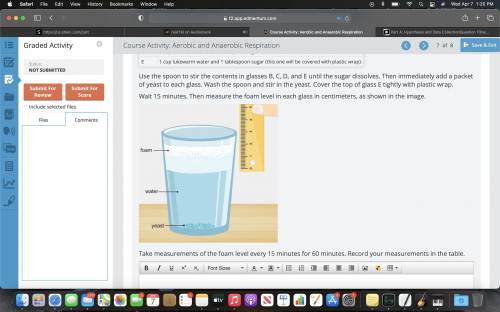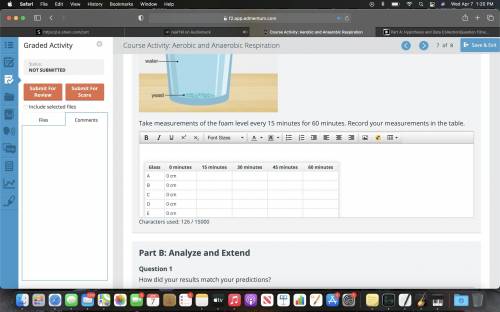Question 2
To prepare for the experiment, follow these steps:
Put one or two ice cubes...

Biology, 07.04.2021 23:30 journey888
Question 2
To prepare for the experiment, follow these steps:
Put one or two ice cubes in 1 cup of water. Chill the cup of water in the refrigerator for 1 to 2 hours. Remove any remaining ice when you take the water out of the refrigerator. This cup holds the ice-cold water.
Heat up three cups of water in the microwave for 15 to 20 seconds until they reach 100°F on the thermometer. If you heat the water too much, wait until the temperature drops to 100°F. These cups hold the lukewarm water.
Heat the last cup of water in the microwave until it reaches 212°F. This cup holds the boiling water.
Now line up the five glasses and label them A, B, C, D, and E. Then put the following contents in each glass:
Glass Contents
A 1 cup lukewarm water
B 1 cup lukewarm water and 1 tablespoon sugar
C 1 cup boiling water and 1 tablespoon sugar
D 1 cup ice-cold water and 1 tablespoon sugar
E 1 cup lukewarm water and 1 tablespoon sugar (this one will be covered with plastic wrap)
Use the spoon to stir the contents in glasses B, C, D, and E until the sugar dissolves. Then immediately add a packet of yeast to each glass. Wash the spoon and stir in the yeast. Cover the top of glass E tightly with plastic wrap.
Wait 15 minutes. Then measure the foam level in each glass in centimeters, as shown in the image.
Take measurements of the foam level every 15 minutes for 60 minutes. Record your measurements in the table.



Answers: 1


Another question on Biology

Biology, 21.06.2019 22:00
(drag each tile to the correct identify which questions can be answered by what can be answered by science or which cannot. -is it right or wrong to use genetic engineering to produce new food products? -what are the most common social settings that tend to produce accomplished artists? -if a new gene is added to the genome of a tomato species, will that species be more resistant to insects? -should humans use biotechnology to bring extinct organisms from the fossil record back to life? -do the types of organisms found in the fossil record appear in consistent sequences in different parts of the world? -are michelangelo's paintings more impressive than rembrandt's?
Answers: 3

Biology, 22.06.2019 03:30
Rease is an enzyme used by plants to break down urea (a nitrogen-containing compound) into carbon dioxide and ammonia. urease urea > > > carbon dioxide and ammonia ammonia is broken down by plants into a nitrogen source plants need to grow. thus, plants could not use urea as a nitrogen source unless it was first converted to ammonia. in soybean plants there are two different kinds of urease, one produced in the seeds and the other produced in the leaves of the plant. three types of soybean plants were used in a set of experiments: normal soybeans and two mutant strains, one lacking the urease in the seeds only (strain 1) and one lacking urease in the leaves only (strain 2). experiment 1 separate areas in a field were planted with normal, strain 1, and strain 2 soybeans. all types of soybeans appeared to grow, flower, and produce seeds equally well. there were no externally detectable differences among the strains. experiment 2 small pieces of plant leaves of equal weight were obtained from each type of soybean plant and separately placed on media in culture dishes. tissue growing in this way will become an unorganized clump of cells referred to as callus. to provide a controlled nitrogen source, half the tissue samples of each type were placed on media containing urea, and the other half of the samples were placed on media containing ammonia. after 30 days, the weight gain for each of the callus samples was determined. results are shown in the table below.
Answers: 2

Biology, 22.06.2019 06:30
Brainliest ! is slowing down a car an example of acceleration? explain. - explain correctly
Answers: 1

Biology, 22.06.2019 06:30
Mitosis creates two identical daughter cells from one parent cell creates four nonidentical daughter cells from one parent cell is the most common type of reproduction for bacteria is the process by which male and female reproductive cells are created
Answers: 1
You know the right answer?
Questions

Mathematics, 17.07.2020 19:01






Mathematics, 17.07.2020 19:01


History, 17.07.2020 19:01






Mathematics, 17.07.2020 19:01



Mathematics, 17.07.2020 19:01





